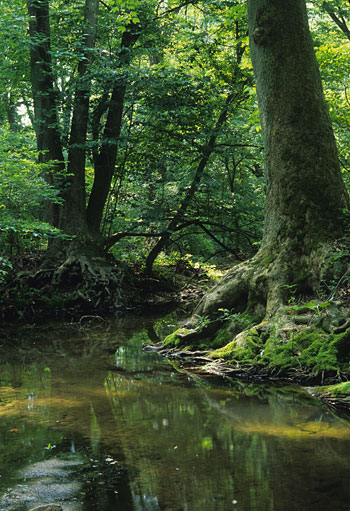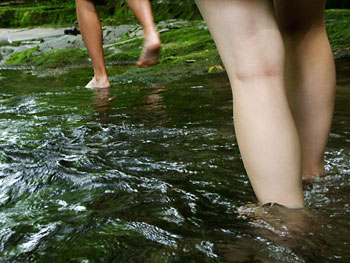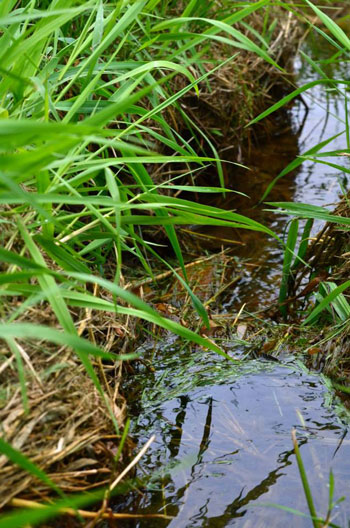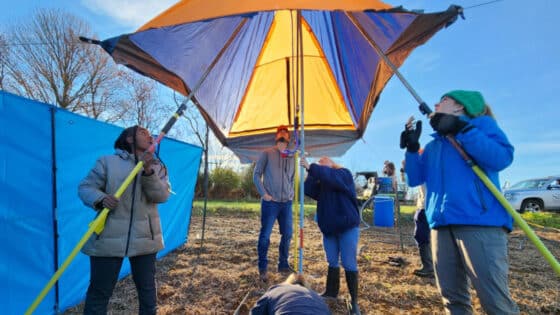
Studies show that incremental contributions of individual streams and wetlands are cumulative across entire watersheds. Photo: Dave Funk
May 27 was a historic day for federal protection of freshwater ecosystems. The United States Environmental Protection Agency (EPA) issued a final rule that clarifies what “waters of the United States” are covered under the Clean Water Act, the national law protecting water quality.
BUT THE BATTLE IS FAR FROM OVER
On June 10th, the U.S. Senate Environment and Public Works Committee advanced a bill (S. 1140) to kill the EPA’s waters of the United States rule and limit which waterways the EPA can regulate. This measure is similar to a bill (H.R. 594) the U.S. House of Representatives passed in May that would require the EPA to withdraw its regulation and draft a new one based on consultation with state and local officials.
Also on June 10, the U.S. House Interior Subcommittee passed an appropriations bill that would cut EPA funding by $718 million, or 9 percent, and cap the agency’s staffing levels. This follows a fiscal 2016 Energy and Water appropriations bill (HR 1732) the U.S. House passed in May that aims to prohibit the EPA from using any appropriated funds for its Clean Water Rule. (See links at end of article.)
Many legislators are responding to industrial interest groups who oppose the EPA’s rule on the belief that it is an “overreach” and “land grab.” The EPA responded that it included numerous exceptions to the draft rule after listening to the concerns of farmers and others. Indeed, many freshwater scientists disapproved of several stated exceptions that are now part of the EPA rule.
Prior to the vote, Senate Environment and Public Works Committee ranking member Sen. Barbara Boxer, of California, issued a statement stating:
“Members of this Committee should understand that when we weaken the Clean Water Act, we are putting people in danger.”
THE CLEAN WATER ACT AND STROUD WATER RESEARCH CENTER WERE BORN SIMULTANEOUSLY
In the late 1960’s, our water resources were in trouble.
- In Ohio, the Cuyahoga River caught on fire.
- Bacteria levels in the Hudson River were 170 times safe levels.
- Pollution from food processing plants in Florida killed a record 26 million fish.
- Two-thirds of the nation’s waters were too polluted for fishing or swimming.

The number of rivers and lakes clean enough for fishing and swimming doubled after the Clean Water Act was passed. Photo: Sarah Pate
During that same era, Dr. Ruth Patrick and the Stroud family created the Stroud Water Research Center in Avondale, Pennsylvania to understand how natural streams work and enable us to measure the damage caused by all of this pollution.
Citizens and politicians joined forces in 1972 to create the US EPA and pass the Clean Water Act. The law declared that all waterways would be “fishable and swimmable” in the next decade.
While we didn’t reach that goal, our waters did get cleaner after the law’s passage. The rapid loss of our wetlands slowed and rivers and lakes began to recover. The number of rivers and lakes clean enough for fishing and swimming doubled.
During this time, Stroud Center built some of the first artificial streams in the world so that our scientists, working with the EPA, could conduct experiments to determine the direct effects of various pollutants in our waterways.
But before long, polluters were violating their permits. They filed lawsuits to weaken the Clean Water Act. Decisions by the U.S. Supreme Court in 2001 and again in 2006, created loopholes that left 20 million acres of wetlands and more than half of America’s streams without guaranteed protections under federal law.
This happened despite the fact that Stroud Center scientists, along with others in the freshwater scientific community, had clearly made the case that all surface flowing waters formed a “continuum” from the headwaters to the estuary. Further, the scientific community has clearly demonstrated that pollution upstream translates into deterioration downstream.
EPA’S RULE IS BASED ON PEER-REVIEWED SCIENCE
Before proposing the Clean Water Rule, scientists in EPA’s Office of Research and Development compiled a survey of peer-reviewed literature. The agency and its collaborating freshwater scientists (including Stroud Center staff) examined the ways in which upstream waters influence downstream water conditions.
After further peer review of their draft report, the independent Science Advisory Board issued a detailed review and the EPA incorporated this feedback into a final “Connectivity Report” released in January. The report relies on more than 1,200 publications and provides the scientific foundation for the final rule.

Streams, regardless of their size or frequency of flow, are connected to downstream waters and strongly influence their function. Photo: Beverly Payton
Not surprisingly, this review found that these water bodies are enormously important. Specifically, the final report found:
- The scientific literature unequivocally demonstrates that streams, regardless of their size or frequency of flow, are connected to downstream waters and strongly influence their function.
- The scientific literature clearly shows that wetlands and open waters in riparian areas (transitional areas between terrestrial and aquatic ecosystems) and floodplains are physically, chemically, and biologically integrated with rivers via functions that improve downstream water quality. These systems act as effective buffers to protect downstream waters from pollution and are essential components of river food webs.
- The literature strongly supports the conclusion that the incremental contributions of individual streams and wetlands are cumulative across entire watersheds, and their effects on downstream waters should be evaluated within the context of other streams and wetlands in that watershed.
THE BOTTOM LINE
The bottom line is that the EPA’s Waters of the United States rule to restore guaranteed protections to tributaries and nearby waters, and to allow for the protection of other waters based on a more localized analysis of their role in downstream water quality, is based on credible, peer-reviewed science.
This science has been the hallmark of Stroud Water Research Center since its founding and since the beginning of the Clean Water Act.
We all can drink to that.
Links
- Clean Water Rule: Definition of “Waters of the United States”, US EPA
- S. 1140, To require the Secretary of the Army and the Administrator of the Environmental Protection Agency to propose a regulation revising the definition of the term “waters of the United States”
- H.R. 594, Waters of the United States Regulatory Overreach Protection Act of 2015
- House panel passes bill that cuts EPA’s budget 9 percent and blocks environmental rules, U.S. News & World Report
- House of Representatives Appropriations Bill
- H.R.1732, Regulatory Integrity Protection Act of 2015
- Society for Freshwater Science comments regarding EPA-HW-OW-2011-0880 “Definitions of Waters of the United States”
- A Brief History of the Clean Water Act, PBS



